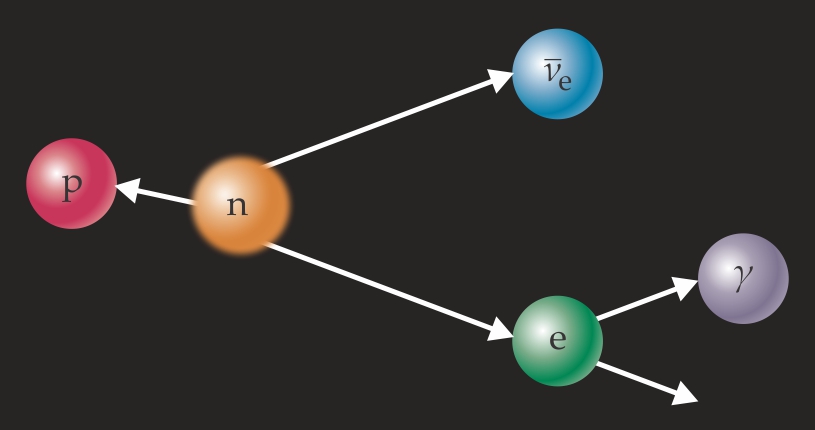The colors of radiative beta decay
DOI: 10.1063/PT.3.3256
The neutron, though an essential component of most stable nuclei, is itself unstable: After a mean lifetime of about 15 minutes, a free neutron decays into a proton, an electron, and an electron antineutrino. Because the process depends on only a handful of parameters, it’s an ideal testing ground for understanding the fundamental physics of the weak interaction.
The sudden creation of a high-speed electron in the decay can be thought of as the rapid acceleration of an electron initially at rest—a process that’s accompanied by radiation, as shown in the

When a decaying neutron produces a photon—in addition to the usual proton, electron, and electron antineutrino—the photon is usually associated with the creation of the electron. The energy distribution of those photons can be predicted by quantum electrodynamics; that prediction has now been experimentally confirmed.

Fifteen years ago, researchers at NIST in Gaithersburg, Maryland, heard about an experiment in preparation at the Institut Laue–Langevin (ILL) in Grenoble, France, to try to measure radiative neutron decay. They realized that their own superconducting magnet, previously used in measurements of the neutron’s lifetime, was ideally suited for them to make their own attempt, which entailed monitoring a neutron beam for the characteristic signature of radiative decay: a proton, electron, and photon all produced at the same time.
The challenge was to distinguish the radiative-decay photons from an overwhelming background of photons from other sources, such as the external bremsstrahlung that’s produced when protons and electrons decelerate in a particle detector. In their RDK experiment (not an abbreviation but a play on the words “radiative decay”), the NIST team and its collaborators used a magnetic field to direct the charged particles away from the path of the neutron beam. As a result, the decay protons and electrons could be efficiently detected without the external bremsstrahlung ever reaching the photon detector.
The ILL experiment measured only an upper bound on the prevalence of radiative decay. 1 Then, in 2006, the RDK collaboration, led by Jeffrey Nico, found that out of every 1000 neutron decays, 3.1 ± 0.3 produced a photon with energy between 15 keV and 340 keV, the range over which their detectors were sensitive. 2
Now Nico and his colleagues have released the results of their follow-up RDK II experiment: They’ve cut their uncertainty in half, extended their energy limits down to 0.4 keV and up to the full 782 keV, and made the first precision measurements of the shape of the radiative decay spectrum. 3
The aim of the original RDK was to test whether radiative decay could be seen at all, so the researchers could disregard many experimental subtleties. For example, the response of the scintillators in the photon detectors isn’t precisely proportional to the incoming photon energy, and the charged particles produced in the decay are sometimes deflected away from the particle detector. Because RDK II no longer had the luxury of ignoring those effects, much of the intervening decade was taken up with auxiliary studies of the detectors’ energy response and detailed Monte Carlo simulations (spearheaded by team member Matthew Bales, now a postdoc at the Technical University of Munich) of every aspect of the experiment.
The spectrum the researchers ultimately derived was fully consistent with theoretical predictions. Indeed, it would have been astonishing if it hadn’t been. Electron inner bremsstrahlung is governed by quantum electrodynamics (QED), a well-understood theory that’s been thoroughly tested, though never before in this particular way.
But QED treats the proton and neutron as point particles rather than as composite particles made up of quarks. Chiral perturbation theory predicts that the nucleons’ internal structure and nonzero size should alter the radiative decay spectrum by about 1%. If RDK’s accuracy can be increased by a further factor of five, the experiment should be sensitive to those effects.
References
1. M. Beck et al., JETP Lett. 76, 332 (2002). https://doi.org/10.1134/1.1525031
2. J. S. Nico et al., Nature 444, 1059 (2006). https://doi.org/10.1038/nature05390
3. M. J. Bales et al., Phys. Rev. Lett. 116, 242501 (2016). https://doi.org/10.1103/PhysRevLett.116.242501
More about the Authors
Johanna L. Miller. jmiller@aip.org




